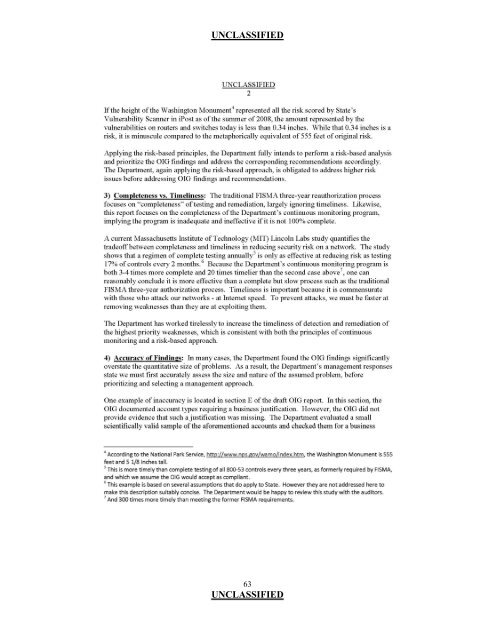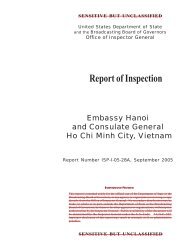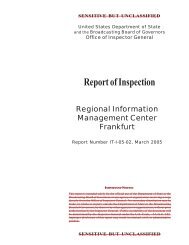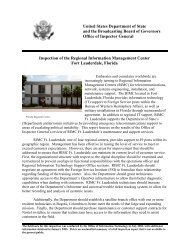Evaluation of Department of State Information Security Program ...
Evaluation of Department of State Information Security Program ...
Evaluation of Department of State Information Security Program ...
You also want an ePaper? Increase the reach of your titles
YUMPU automatically turns print PDFs into web optimized ePapers that Google loves.
UNCLASSIFIED<br />
UNCLASSIFIED<br />
2<br />
If the height <strong>of</strong> the Washington Monument 4 represented all the risk scored by <strong>State</strong>'s<br />
Vulnerability Scanner in iPost as <strong>of</strong> the summer <strong>of</strong>2008, the amount represented by the<br />
vulnerabilities on routers and switches today is less than 0.34 inches. While that 0.34 inches is a<br />
risk, it is minuscule compared to the metaphorically equivalent <strong>of</strong> 555 feet <strong>of</strong> original risk.<br />
Applying the risk-based principles, the <strong>Department</strong> fully intends to perform a risk-based analysis<br />
and prioritize the OIG findings and address the corresponding recommendations accordingly.<br />
The <strong>Department</strong>, again applying the risk-based approach, is obligated to address higher risk<br />
issues before addressing OIG findings and recommendations.<br />
3) Completeness vs. Timeliness: The traditional FISMA three-year reauthorization process<br />
focuses on "completeness" <strong>of</strong>testing and remediation, largely ignoring timeliness. Likewise,<br />
this report focuses on the completeness <strong>of</strong> the <strong>Department</strong>'s continuous monitoring program,<br />
implying the program is inadequate and ineffective if it is not 100% complete.<br />
A current Massachusetts Institute <strong>of</strong> Technology (MIT) Lincoln Labs study quantifies the<br />
trade<strong>of</strong>f between completeness and timeliness in reducing security risk on a network. The study<br />
shows that a regimen <strong>of</strong> complete testing annually5 is only as effective at reducing risk as testing<br />
17% <strong>of</strong> controls every 2 months. 6 Because the <strong>Department</strong>'s continuous monitoring program is<br />
both 3-4 times more complete and 20 times timelier than the second case above 7, one can<br />
reasonably conclude it is more effective than a complete but slow process such as the traditional<br />
FISMA three-year authorization process. Timeliness is important because it is commensurate<br />
with those who attack our networks - at Internet speed. To prevent attacks, we must be faster at<br />
removing weaknesses than they are at exploiting them.<br />
The <strong>Department</strong> has worked tirelessly to increase the timeliness <strong>of</strong> detection and remediation <strong>of</strong><br />
the highest priority weaknesses, which is consistent with both the principles <strong>of</strong> continuous<br />
monitoring and a risk-based approach.<br />
4) Accuracy <strong>of</strong> Findings: In many cases, the <strong>Department</strong> found the OIG findings significantly<br />
overstate the quantitative size <strong>of</strong> problems. As a result, the <strong>Department</strong>'s management responses<br />
state we must first accurately assess the size and nature <strong>of</strong> the assumed problem, before<br />
prioritizing and selecting a management approach.<br />
One example <strong>of</strong> inaccuracy is located in section E <strong>of</strong> the draft OIG report. In this section, the<br />
OIG documented account types requiring a business justification. However, the OIG did not<br />
provide evidence that such a justification was missing. The <strong>Department</strong> evaluated a small<br />
scientifically valid sample <strong>of</strong> the aforementioned accounts and checked them for a business<br />
' According to the National Park Service, http://www.nps.gov!wamo!index.htm. the Washington Monument is 555<br />
feet and 51/8 inches tall.<br />
' This is more timely than complete testing <strong>of</strong> all 800-53 controls every three years, as formerly required by FISMA,<br />
and which we assume the DIG would accept as compliant.<br />
• This example is based on several assumptions that do apply to <strong>State</strong>. However they are not addressed here to<br />
make this description suitably concise. The <strong>Department</strong> would be happy to review this study with the auditors.<br />
, And 300 times more timely than meeting the former FISMA requirements.<br />
63<br />
UNCLASSIFIED








